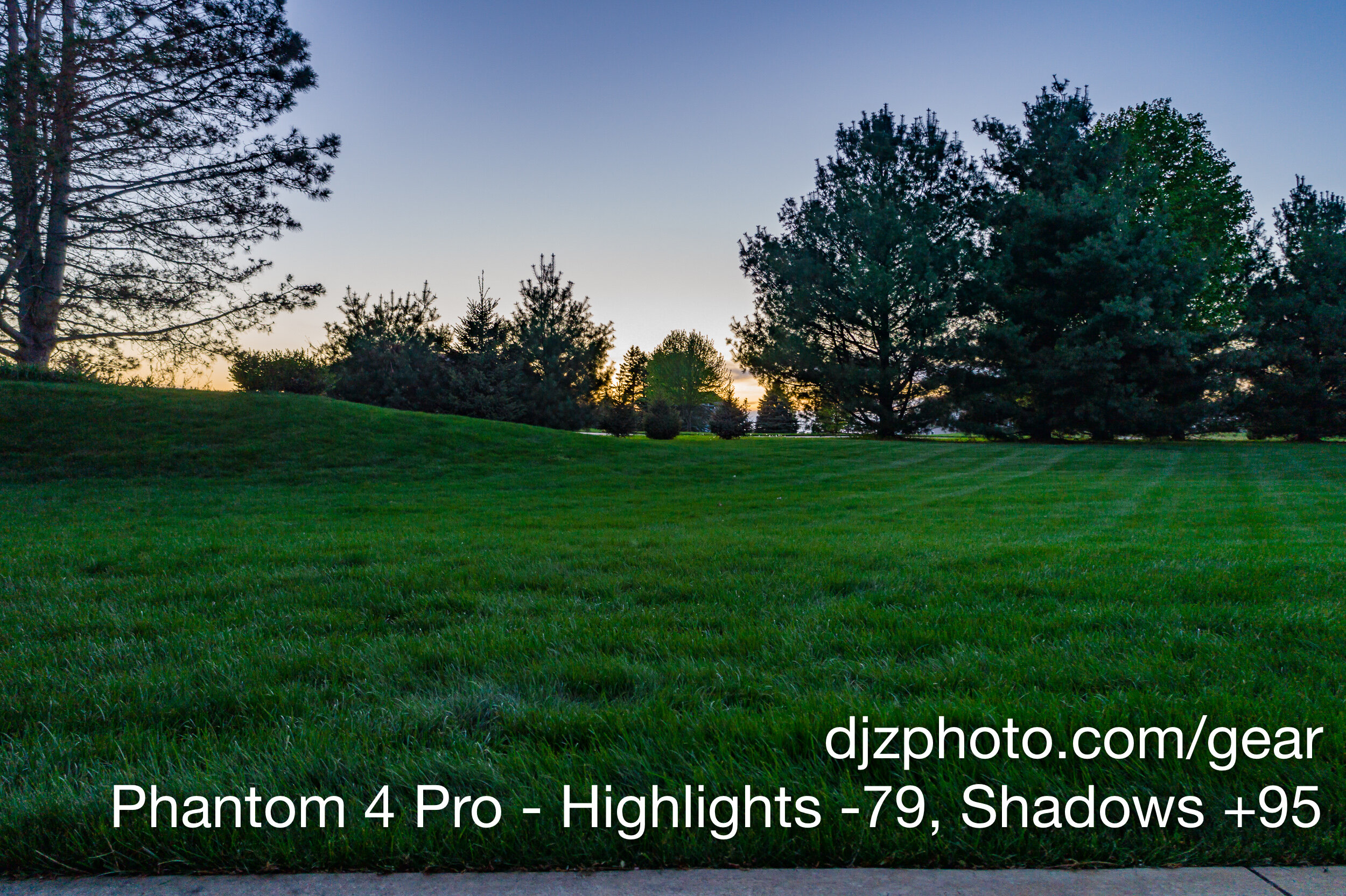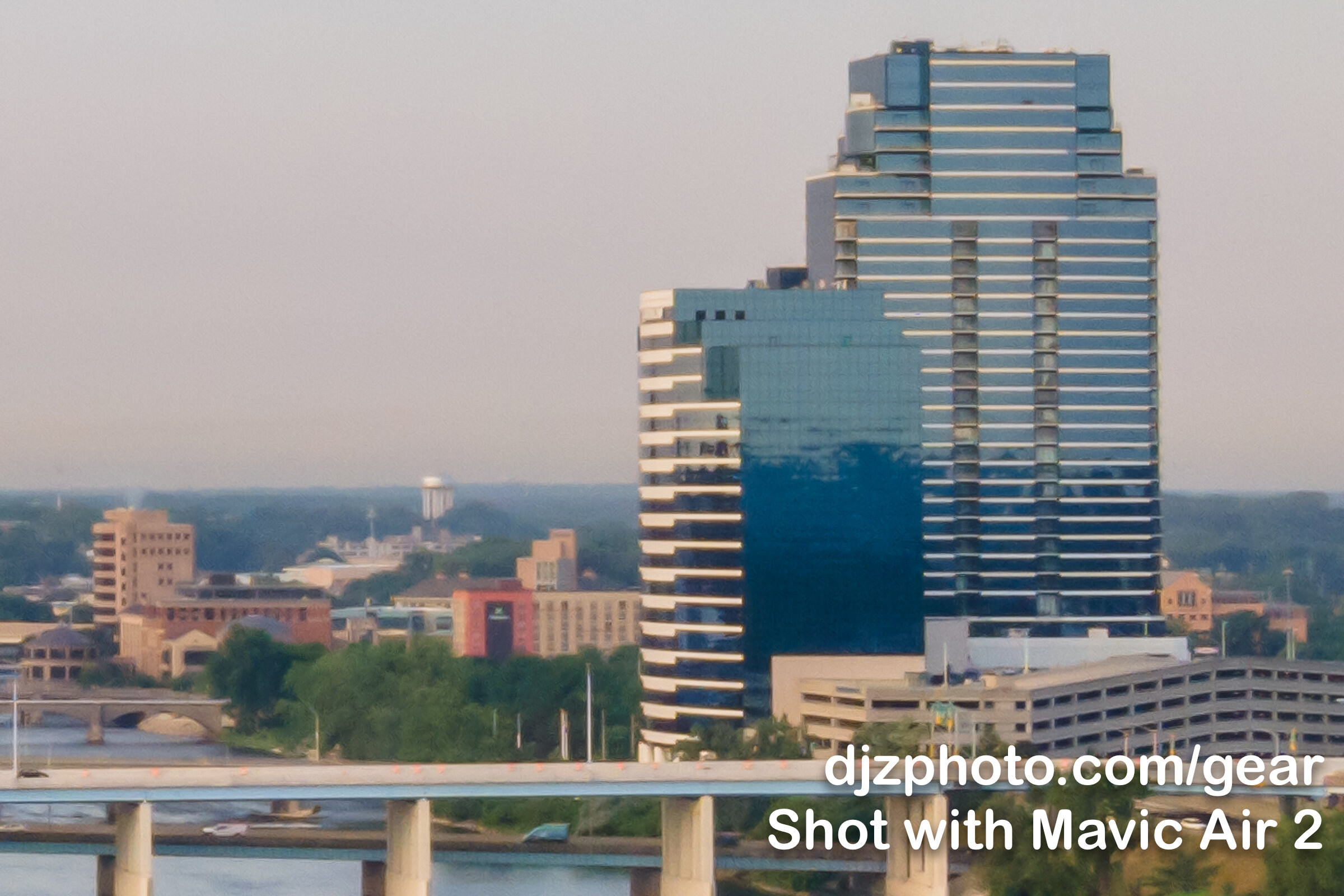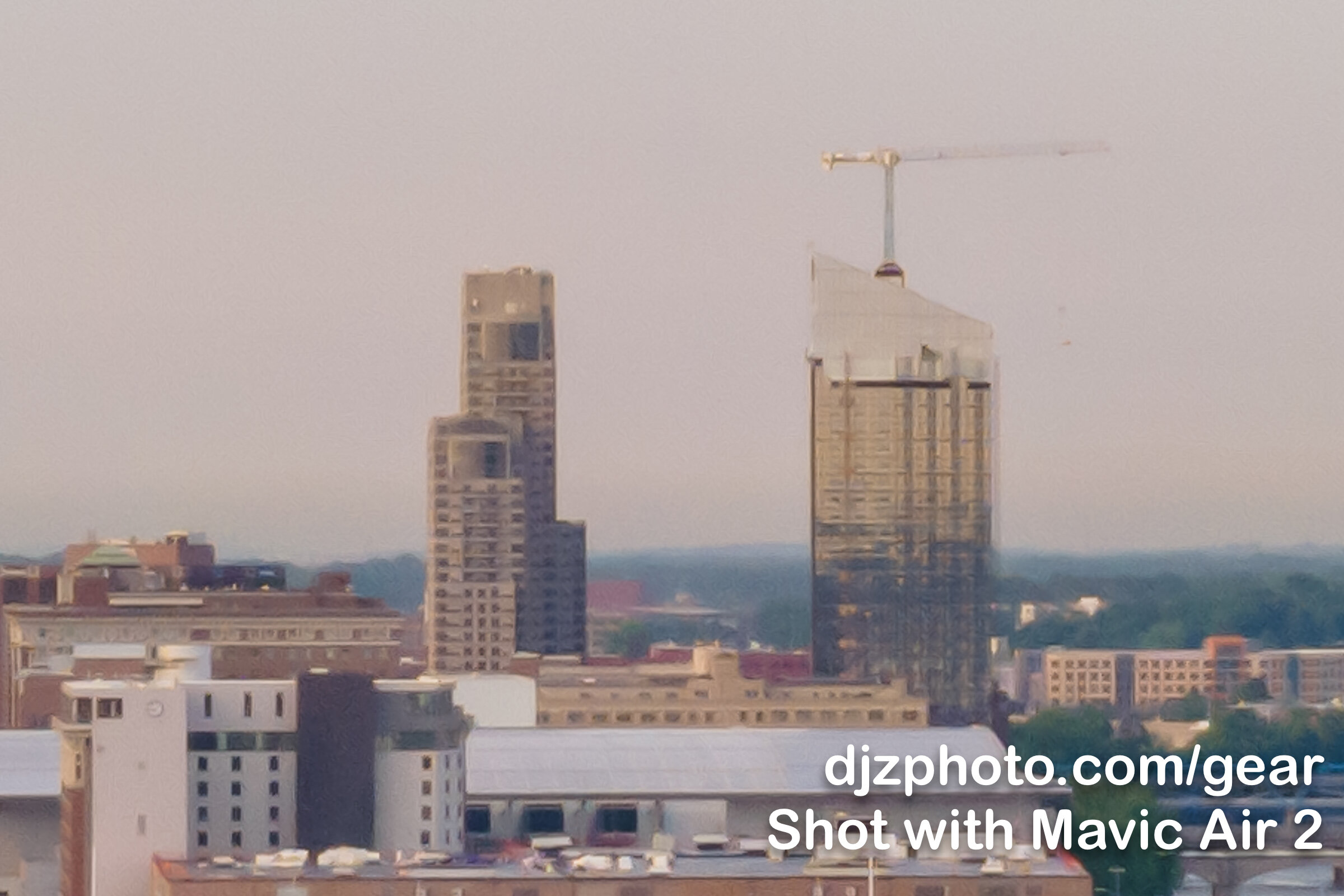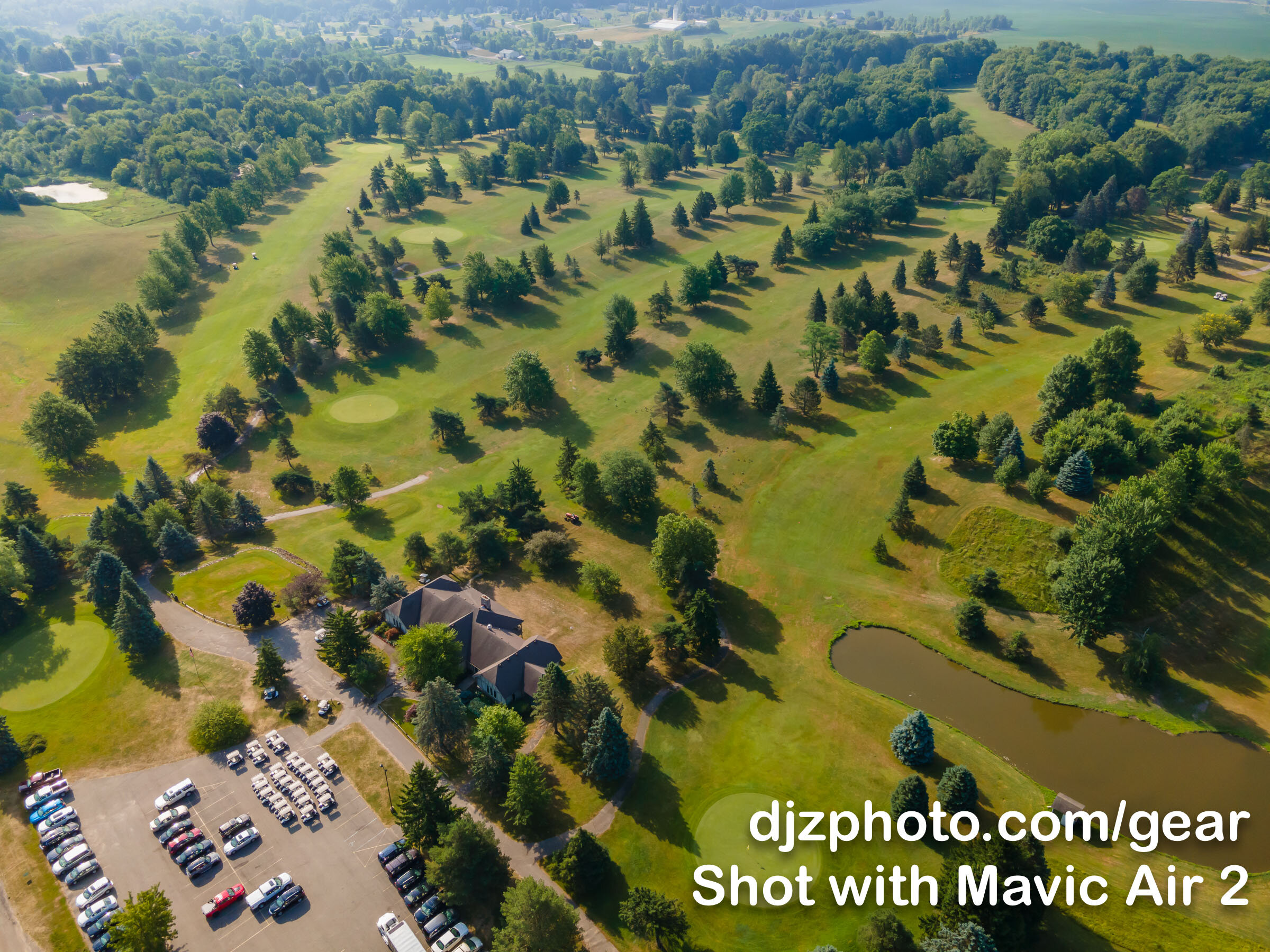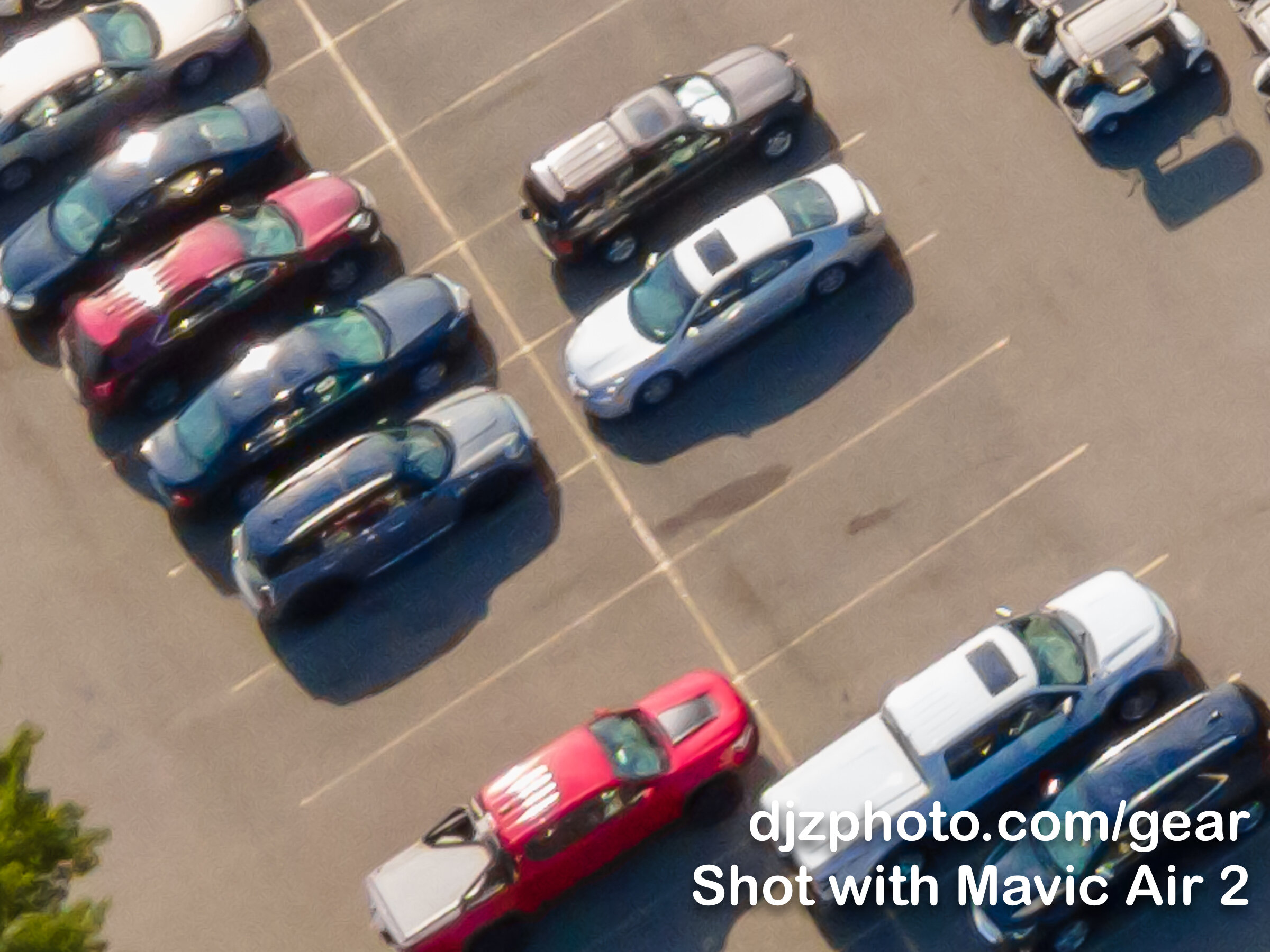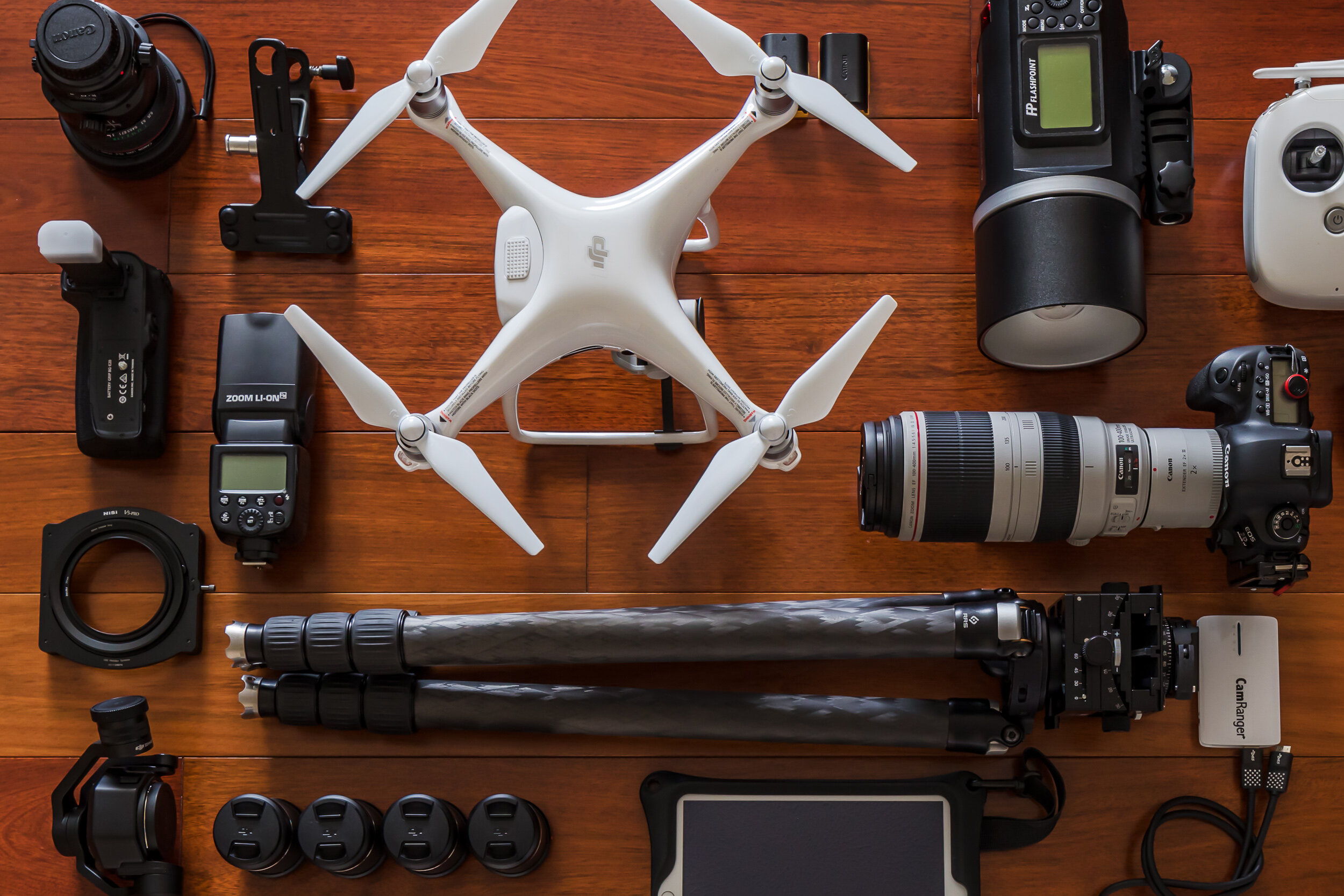
Camera & Drone Gear Blog
Info, Reviews, Comparisons, & News
DJI Air 2S Review: Has DJI Finally Created a Superior Successor to the Phantom 4 Pro??
DJI has released the “DJI Air 2S” as the latest drone in the Mavic series. It has the same size sensor and photo resolution as the Mavic 2 Pro and the Phantom 4 Pro with 4K video @ 60fps or 5.4K video @ 30fps. Has DJI finally released a travel-sized drone that can replace my 4-year-old Phantom 4 Pro???
Testing the image quality of the DJI Air 2S vs. the trusty old Phantom 4 Pro. Will the latest Mavic be my new go-to compact travel drone? Or should I clean the bug guts off the Phantom 4 Pro and keep using it for another year?
I have had a Phantom 4 Pro since February of 2017. It has been my go-to drone for real estate photography and video for a few years. But at some point I can’t help but wonder, “How long do these things last? Is DJI going to release a superior compact travel drone for me to upgrade to someday? Should I just fly this Phantom 4 Pro for years until a motor fails and it crashes in a field?”
Back when the Mavic 2 Pro came out in 2018 many people thought of that drone as the successor to the Phantom 4 Pro, but the Mavic 2 Pro could only do video at 4K @ 30fps, whereas the Phantom 4 Pro could do 4K @ 60fps. So the Mavic 2 Pro failed to be a totally superior successor, though it has been a popular model.
When the DJI Mavic Air 2 came out in 2020 with a 48-megapixel camera (better thought of as a 12MP quad bayer sensor) that could shoot 4K @ 60fps I had high hopes about that being my new compact travel drone, but knowing it had a smaller sensor than the Phantom 4 Pro I had my suspicions. Once I got ahold of one I pitted the Mavic Air 2 against the Phantom 4 Pro in a series of photo quality tests, and I generally preferred the image quality of the Phantom 4 Pro’s camera over the Mavic Air 2. So the Mavic Air 2 didn’t end up replacing my trusty old Phantom 4 Pro.
Now in April 2021 DJI has released the “DJI Air 2S” as the latest drone in the Mavic series. It has the same size sensor and photo resolution as the Mavic 2 Pro and the Phantom 4 Pro with 4K video @ 60fps or 5.4K video @ 30fps. Has DJI finally released a travel-sized drone that can replace my 4-year-old Phantom 4 Pro???
This page contains links to products, so if you find this site useful and use a link to make a purchase, I’ll get a small commission. As an Amazon Associate I earn from qualifying purchases. Enjoy!
Shortly after my DJI Air 2S arrived I took it along with my Phantom 4 Pro (P4P) to a couple locations to test out the cameras, because I enjoy meticulously analyzing photo quality (i.e. I’m a dork). The first location was a park. Here are some unedited photos looking straight down at about 393 feet AGL:
The first thing you may notice in the two photos above is that the DJI Air 2S appears to be zoomed out more than the Phantom 4 Pro, even though they are about the same altitude. This is expected because DJI lists the Air 2S as having a 22mm full-frame equivalent focal length, and lists the Phantom 4 Pro as having a 24mm full-frame equivalent focal length. The Mavic 2 Pro has a 28mm focal length. Obviously one focal length is not better than the other, it just depends on the situation.
The other thing I noticed but was NOT expecting is that with these unedited DNG(RAW) photos the Air 2S has better color and contrast than the Phantom 4 Pro right out of the camera. Chalk that up as a win for the DJI Air 2S!
Now let’s see if we can see a difference in sharpness when we zoom in on these photos.
When looking at these crops keep in mind that the DJI Air 2S camera and the Phantom 4 Pro are both about the same distance from the subject (the ground at the park park), but the Phantom is “zoomed in” to 24mm while the Air 2S is “zoomed out” to 22mm. This should be an advantage for the Phantom 4 Pro when comparing crops of the same sized area of the park. If you have two cameras with equal lens sharpness and sensor resolution both the same distance from the subject, but one is at 22mm and the other at 24mm, the camera at 24mm should capture more detail of the subject since it is zoomed in farther.
In the extreme crops of the lower left, middle, and lower right areas of the park photos, the DJI Air 2S crops are 513 x 341 and the Phantom 4 Pro crops are around 570 x 380 (one of them is 576 x 384) due to the variance in focal length between the two drones. If both cameras/lenses were equally sharp the Phantom 4 Pro should have no problem winning, because it is zoomed in farther and has about 23% more pixels covering each cropped comparison area.
With that in mind, can the Air 2S can still win?
Before we jump in I would just like to say it’s obvious that either drone can produce great photos for a variety of professional purposes and I am cropping these more than anyone should ever need to crop them for a real project. We are just going to be looking at the fine details with extreme closeups to see if there’s a noticeable difference.
Here is the first crop from the lower left corner of the main park images:
Surprisingly, despite the Air 2S crop being only (513x341) vs. the P4P crop being (576x384), there is actually more definition in the Air 2S crop. The branches over the white table are sharper and more defined and you can see the brick lines better.
Let’s take a look at an extreme closeup near the middle of the full images:
In this close up of the middle of the photos it’s hard to say which crop has more detail, which in itself is a win for the DJI Air 2S since it’s accomplishing a similar amount of detail with fewer pixels in the crop.
Now let’s take a look at another crop from the lower right corner of the full images:
In this crop you can see significant green and magenta fringing around the edges of the white crosswalk paint and along the edges of the cement in the (570x380) P4P crop, and the fringing is almost non-existent in the (513x341) Air 2S crop. You can also see more detail and less color fringing on the yellow/green crosswalk sign with the Air 2S. Adobe Lightroom was applying lens corrections to both images.
Just so I don’t base my entire test around one photo, let’s take a look at some photos in the city!
These photos were both taken from about the same altitude and location (though it looks like I may have been 5 or 10 feet higher with the DJI Air 2S), and you can again see the difference between the focal lengths of 22mm and 24mm. The DJI Air 2S had better color and contrast right out of the camera for the city scene as well:
Now let’s check out an extreme crop of the left side:
The biggest difference in these drones really shows up at the edges of photos, which is where many lenses show their weaknesses. The (513x341) Air 2S crop of the left side is much cleaner, sharper, and more defined than the (570x380) P4P crop. You can compare the building edges & windows in these crops to see how there’s fairly significant green/magenta fringing on the edge of the P4P lens that’s almost non-existent with the Air 2S.
One more crop from the right side:
There isn’t a ton of difference in this crop, but something that I noticed quickly is how it looks like both cameras ran into a bit of a moiré issue with the right side of that building where the lines were close together. I used a radial filter in Adobe Lightroom to correct the moiré, and here’s the updated comparison:
With the moiré not distracting from the side of the building it looks like the window lines where the moiré was are slightly more defined and less noisy in the (513x341) Air 2S crop than the (570x380) P4P crop. There also might be a little more color fringing and noise with the P4P, but other than that there’s not a huge difference.
I wanted to do one more test in a high dynamic range situation after sunset where the foreground was very dark. In order to take photos at the exact same time identical lighting in each shot I just set both drones on a table and took the photos at the exact same time. Here are the original unedited photos taken at ISO 100, f/2.8, 1/25th shutter speed:
Here are the same photos with highlights reduced to -79 and shadows cranked to +95 in Adobe Lightroom:
And here are crops of the center of each photo:
If you compare the lower part of the tree trunk in the middle, the pine branches, and tree leaves, you can see how much sharper the Air 2S is right in the center of this high dynamic range scene.
Conclusion
The only thing I miss while using the included DJI Air 2S remote and the DJI Fly app is the ability to change camera settings with the wheel on the remote. With the remotes included with the Inspire 2 or Phantom 4 Pro you can press the right wheel to cycle through camera settings and then turn the wheel to change a setting in the DJI Go app. With the DJI Air 2S remote you have to tap on the screen and drag the slider to change values like shutter speed, ISO, or white balance.
Other than minor differences in the remote & app, after comparing the photo capability of the DJI Air 2S with my trusty Phantom 4 Pro in a variety of situations it is clear the Air 2S has a much sharper camera/lens combination. The sharper lens combined with the highest video resolution of any compact drone from DJI (i.e. smaller than an Inspire) has made the DJI Air 2S my new favorite travel drone.
If you found this article helpful and are planning on making a purchase, consider using one of the links on this page and I’ll get a small commission. Thanks!
DJI on Amazon
Megapixels vs. Sensor Size: Can the Mavic Air 2 Beat the Phantom 4 Pro?
I got ahold of a Mavic Air 2, and I just had to know how its higher resolution images compared to the 20 megapixel Phantom 4 Pro and its 13.2 x 8.8mm sensor. If the sensor sizes were the same, I would expect the sensor with more pixels to be the winner. But how do they compare when the higher resolution photos are from a much smaller sensor (6.4 x 4.8mm)? Let’s take a look.
See Also: DJI Drone Sensor Size Comparison Page
See Also: DJI Air 2S Review: Has DJI Finally Created a Superior Successor to the Phantom 4 Pro??
See Also: DJI Mavic 3 vs. DJI Air 2S - Image Quality Tests, Comparison and Review
See Also: Pelican 1400 Protector Case - A Customizable Waterproof Case for DJI Mavic Series Drones
( This page contains links to products, so if you find this site useful and use a link to make a purchase, I’ll get a small commission. As an Amazon Associate I earn from qualifying purchases. Thanks!)
When DJI announced the Mavic Air 2, I was a bit surprised at its max photo resolution of 8000x6000. Why, that’s 48 megapixels from a 6.4 x 4.8mm sensor! Considering all their more expensive drones with larger sensors produce images around 20 megapixels, what is going on with the camera on this new little drone?
I have had a Phantom 4 Pro for a few years, and they haven’t really released a sub-$2,000 drone with a better camera (as of July 2020). The Mavic 2 Pro is the closest to the Phantom 4 Pro with the same sensor size and photo resolution (though it is 28mm instead of the Phantom 4 Pro’s 24mm), but the Phantom 4 Pro from November 2016 still has better video specs than the Mavic 2 Pro.
2021 Update: DJI has now released the DJI Air 2S (also known as the Mavic Air 2S) which is a MUCH better drone than the Mavic Air 2. See my other article that tests the image quality of the DJI Air 2S vs. the Phantom 4 Pro.
I got ahold of a Mavic Air 2, and I just had to know how its higher resolution images compared to the 20 megapixel Phantom 4 Pro and its 13.2 x 8.8mm sensor. If the sensor sizes were the same, I would expect the sensor with more pixels to be the winner. But how do they compare when the higher resolution photos are from a much smaller sensor? Let’s take a look.
For the first shot, I took both drones to a lake:
The first thing I noticed is the Mavic Air 2’s max resolution is a 4x3 ratio (like a smartphone), whereas the more expensive drones (and most professional cameras) have a 3x2 ratio.
Both images seem great overall, so let’s take a closer look. For the first crop, I zoomed way in to the house on the little pointe in the upper left corner of the main shot:
The first thing I notice when comparing these two crops is that the Phantom 4 Pro seems to produce a much “cleaner” image with less random noise overall. The Mavic Air 2’s noise has the effect of making the image look like it was painted onto a rough texture when we are zoomed in extremely far. The Phantom 4 Pro (P4P) handles the trees with more sharpness and clarity, and produces less noise on the water. The brown house looks sharper and cleaner on the P4P with a sharper, cleaner, more defined shape.
One area I might give a win to the Mavic Air 2 (MA2) would be the shape of the boats to the right of the house. The MA2 picked up the shape of the boats better than the P4P, though there is a bit of noticeable color fringing.
The next crop is the closer house in the middle of the main images:
Again we can see the P4P produces a cleaner image overall. The window lines are more clearly defined and less noisy, the trees are more natural looking and defined, and the shingles on the roof look more natural and defined.
It is interesting to look at the MA2’s effect on the roof shingles at this extreme level of zoom… it’s almost as if the roof shingles have completely changed into an entirely different pattern.
That’s not to say the MA2 lost in every way… I think it did a better job of defining the curved line where the grass meets the cement, and a nicer job with the curved steps on the back patio area. I also think the MA2 did a better job defining the patio furniture in the upper left corner of this crop, and some of the roof lines seem sharper and more defined.
The last crop at the lake will be the boat, lift, and dock to the left of the houses in the middle of the main images:
In the above cropped images the P4P handles the tree leaves much better on the right. The MA2 turns the leaves into odd shapes that almost look like a painting. The P4P also did a better job with the water, as you can see the waves & ripples more clearly defined with less noise. The P4P also has less color fringing on the bright areas like the dock and raft.
The MA2 managed to define the shape of the blue boat lift canopy by the dock better, albeit with more noise than the P4P.
For the next setting I went to a park located north of Grand Rapids, Michigan, and took a shot facing south towards the city. Below are the main shots, which seem similar in quality and would be fine to use in most professional projects:
The first crop will be the big building to the right of the river:
The P4P handles the windows and lines on the buildings in this crop much better, with less noise and a more defined & natural look. The buildings and trees in the background are cleaner, sharper, and more defined. The supports under the nearest bridge are also clearer and sharper. Nothing in this crop jumped out at me as looking better on the MA2.
The next crop we can meticulously analyze will be the buildings in the distance to the left of the river:
I will have to give the win to the Phantom 4 Pro! Cleaner, sharper, more defined, more natural looking.
The MA2 does seem to have more sharpness and definition in the construction crane on top of the building though.
The last crop of the city photos will be some of the closer buildings to the left of the river:
In the above crops it seems like the MA2 again pulls a little more definition in the construction cranes. In this image I found it a little tougher to declare a winner, but the P4P does do a better job with the lines and windows on buildings. The P4P also better defines the tree line and buildings in the background near the upper right corner.
For the final photo location, I took the Phantom 4 Pro and the Mavic Air 2 to a golf course on a hot, hazy summer morning:
The first crop will show the area directly in front of the clubhouse:
In the above crop, the MA2 seems to pull more definition if you look at the roofs on the golf carts. But if you look at the shadow of the big tree in the upper left corner, there is a lot more noise in the MA2 image. Also, the P4P continues to handle the appearance of tree leaves much better (especially the tree on the right).
Next, we’ll zoom in to the shed by the little pond:
If you look at the door on the shed and the shingles on the roof, the P4P shows less noise and more definition, contributing to a more natural look. The water is less noisy on the P4P photo, and… this is the last time I will need to say it… but the leaves and grass on the P4P are more defined.
In the last comparison crop, we’ll take a look at the cars in the parking lot. This was a useful crop because it shows a big difference between the two cameras:
Look at all the sun glares on the cars in the MA2’s photo, and you will see… rampant purple! Look at the same glares in the P4P images, and you see the purple fringing is much more controlled. Wherever you have high contrast bright spots, you will often see purple fringing on the MA2.
I cranked the purple defringe amount to 7 under Adobe Lightroom’s manual lens correction panel, and here is the result:
Lightroom was able to correct the purple fringing for the most part, so that’s good that it’s a fairly easy fix.
Conclusion
I wanted to answer the question, “Are megapixels more important than sensor size?” I think we can answer that question with a “probably not.” In this case, the larger sensor on a 2016 Phantom 4 Pro was able to produce generally better images than a smaller sensor from 2020, even though the smaller Mavic Air 2 produces images with more than twice as many pixels. The P4P’s images were cleaner and handled trees, water, and buildings with more clarity & detail.
(I use the phrase “probably not” because the Mavic Air 2 from 2020 would beat a 6 megapixel APS-C camera sensor from 2006, but that’s obviously an extreme comparison)
That being said, whether you use a Phantom 4 Pro, Mavic 2 Pro, or Mavic Air 2, you have a more than capable drone that can capture quality photos & video for a variety of projects in a variety of environments. It will be hard to tell the difference between an image produced on a Mavic Air 2 and a Phantom 4 Pro (other than the aspect ratio) when you’re looking at the entire image. Whether you’re shooting aerial photos for real estate, landscape photography, or for fun, any of these drones are great options! So here are some additional thoughts I have on the Mavic Air 2 that may help you decide if it’s right for you.
Mavic Air 2 Pros
Super compact, easily fits in a camera bag or carry-on bag
Propellers fold in for transportation without detaching them
Relatively quiet and unobtrusive (especially compared with a Phantom 4 Pro)
Costs half as much as a Phantom 4 Pro or Mavic 2 Pro
Super simple remote app for beginners
Produces great images for most purposes
Only with extreme cropping & zooming will you notice a benefit with the larger, more expensive drones
Mavic Air 2 Cons
Bigger & more expensive drones produce moderately better images that may be helpful for larger prints
I feel like it is more likely to be attacked by or accidentally collide with birds than a larger, louder drone (fortunately I haven’t personally confirmed this)
Remote app and camera options might feel too limited and minimal for professionals (you have to use “DJI Fly,” not the “DJI Go” app)
If you want burst shooting or Automatic Exposure Bracketing (AEB), you have to shoot at 12 megapixels, not 48
2021 Update: DJI has now released the DJI Air 2S (also known as the Mavic Air 2S) which is a MUCH better drone than the Mavic Air 2. See my other article that tests the image quality of the DJI Air 2S vs. the Phantom 4 Pro.
Hopefully this article has been helpful. If you want to support more articles like this, feel free to use any link on this page if you make a purchase. Thanks!
Side Note: This test is also relevant when considering how modern day smartphones are starting to have huge megapixel numbers that are higher than the megapixel numbers of large full-frame cameras. Does that mean that smartphones are as good as full-frame cameras?? The answer is “probably not,” because full frame cameras have much larger sensors.























